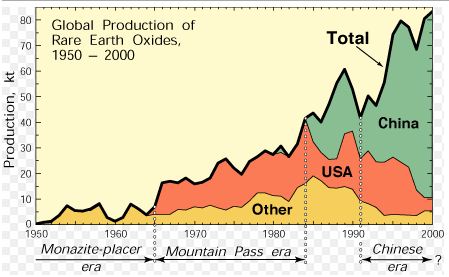The rare earth elements are not ‘earths’ but metals. Nor are they rare. They are expensive because they are difficult to extract.
Thorium isn’t a rare earth. It is generally found as a by-product of the processing of Monazite ore for rare earths elements (REEs).
Thorium is a radio-active metal approximately three times as abundant as Uranium. I’ll come back to Thorium in a minute.
REEs are used in the production of automotive catalysts, pigments, batteries and magnets. Many of the ‘high tech’ items we take for granted depend on them. Demand for REEs is increasing.
China produces virtually all (97%) of the world’s rare earths. In 2009 China announced that over the next few years it would reduce supply from about 70,000 tons per year to 35,000 tons per year.
In September of this year, China said that it would cease supply of rare earth oxides to Japan completely. Given that Japan is a leading manufacturer of mobile phones, TVs, electronic medical equipment, etc, this is potentially devastating to Japan’s economy.
Japan cannot afford to be without REEs.
However… China is not the world’s largest supplier of REEs because it has the largest deposits, but because its low labour costs meant that in the 1980s it was able to force every other producer out of the market.
Up until the middle of last century, most REEs were exported from Brazil or India. Later the US (California) was the leading producer.
The two main ores from which REEs are extracted are Monazite and Bastnasite. Bastnasite has been preferred because the cost of removing Uranium and Thorium in Monazite has been prohibitive.
Australia has good (nowhere near the most, but good) supplies of Monazite.
Two things are happening which will make Australian production of Monazite viable.
First, China’s massive reduction in exports of REEs.
Secondly, new developments in the use of Thorium in nuclear power generation.
A ton of Thorium can generate as much power as 200 tons of Uranium. Thorium reactions do not produce Plutonium.
Plutonium is one of the key ingredients of nuclear weapons. Weapons production was the reason Uranium based reactors became the standard.
Despite this, Thorium based reactors are now on the verge of being commercially viable.
They are safer, more efficient, and more secure – there is no risk of by-products being diverted into weapons production. So Iran, for example, could have nuclear power without giving everyone the heebie-geebies about the possibility of its developing nuclear weapons.
This means that Thorium will no longer be a low value, nuisance by-product, but a valuable resource in itself. Australia has some of the world’s highest Thorium deposits.
So by investing in the development of Australian Monazite deposits, you could potentially make a fortune, help to deliver energy to the world’s poorest nations, and make the world safer, all at the same time.
Cool!




Leave a Reply